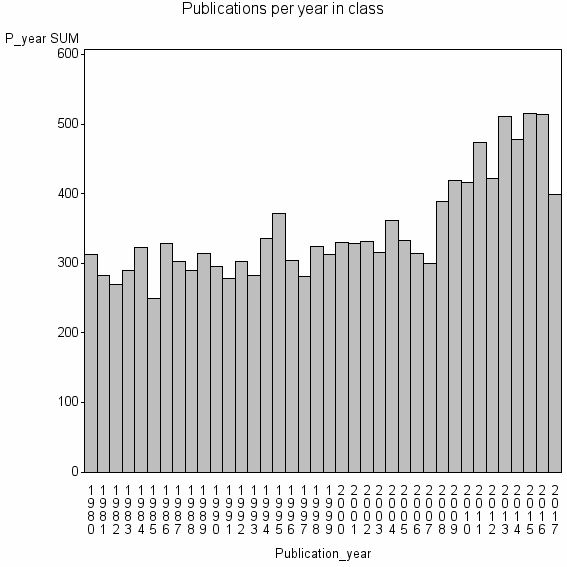
Class information for: |
Basic class information |

Hierarchy of classes |
The table includes all classes above and classes immediately below the current class. |
Terms with highest relevance score |
| rank | Category | termType | chi_square | shrOfCwithTerm | shrOfTermInClass | termInClass |
|---|---|---|---|---|---|---|
| 1 | REM SLEEP | authKW | 771907 | 5% | 50% | 645 |
| 2 | SLEEP | authKW | 702065 | 15% | 15% | 1918 |
| 3 | DREAMING | journal | 566087 | 2% | 82% | 289 |
| 4 | SLEEP DEPRIVATION | authKW | 448556 | 5% | 30% | 625 |
| 5 | SLOW WAVE SLEEP | authKW | 408592 | 2% | 52% | 327 |
| 6 | SLEEP SPINDLES | authKW | 311705 | 1% | 67% | 194 |
| 7 | RAPID EYE MOVEMENT SLEEP | authKW | 241998 | 2% | 50% | 203 |
| 8 | PARADOXICAL SLEEP | authKW | 224744 | 1% | 66% | 142 |
| 9 | DREAMS | authKW | 210486 | 2% | 40% | 221 |
| 10 | PEDUNCULOPONTINE NUCLEUS | authKW | 181737 | 1% | 60% | 128 |
Web of Science journal categories |
| chi_square_rank | Category | chi_square | shrOfCwithTerm | shrOfTermInClass | termInClass |
|---|---|---|---|---|---|
| 1 | Neurosciences | 109897 | 53% | 1% | 6957 |
| 2 | Psychiatry | 24177 | 16% | 1% | 2139 |
| 3 | Clinical Neurology | 21844 | 19% | 0% | 2476 |
| 4 | Behavioral Sciences | 13699 | 8% | 1% | 1008 |
| 5 | Psychology, Biological | 9851 | 3% | 1% | 423 |
| 6 | Physiology | 5266 | 8% | 0% | 1021 |
| 7 | Psychology, Multidisciplinary | 5037 | 5% | 0% | 650 |
| 8 | Psychology, Experimental | 4406 | 4% | 0% | 578 |
| 9 | Psychology | 3931 | 4% | 0% | 560 |
| 10 | Pharmacology & Pharmacy | 807 | 7% | 0% | 958 |
Address terms |
| chi_square_rank | term | chi_square | shrOfCwithTerm | shrOfTermInClass | termInClass |
|---|---|---|---|---|---|
| 1 | SLEEP | 85934 | 2% | 12% | 298 |
| 2 | SLEEP COGNIT NEUROSCI | 50489 | 0% | 92% | 23 |
| 3 | DREAM NIGHTMARE | 45806 | 0% | 80% | 24 |
| 4 | SLEEP COGNIT | 37810 | 0% | 36% | 44 |
| 5 | SERV 151A3 | 32146 | 0% | 84% | 16 |
| 6 | SLEEP NEUROIMAGING | 31196 | 0% | 59% | 22 |
| 7 | SLEEP PERFORMANCE | 25868 | 0% | 28% | 39 |
| 8 | VET COMPARAT ANAT PHARMACOL PHYSIOL | 24525 | 1% | 14% | 76 |
| 9 | STUDY BRAIN SLEEP | 23377 | 0% | 70% | 14 |
| 10 | SLEEP P NEUROBIOL | 22843 | 0% | 20% | 47 |
Journals |
| chi_square_rank | term | chi_square | shrOfCwithTerm | shrOfTermInClass | termInClass |
|---|---|---|---|---|---|
| 1 | DREAMING | 566087 | 2% | 82% | 289 |
| 2 | SLEEP | 259883 | 5% | 16% | 704 |
| 3 | JOURNAL OF SLEEP RESEARCH | 161995 | 2% | 21% | 318 |
| 4 | ARCHIVES ITALIENNES DE BIOLOGIE | 34897 | 1% | 13% | 112 |
| 5 | SLEEP MEDICINE REVIEWS | 28060 | 1% | 13% | 90 |
| 6 | ELECTROENCEPHALOGRAPHY AND CLINICAL NEUROPHYSIOLOGY | 13647 | 1% | 4% | 142 |
| 7 | BIOLOGICAL PSYCHIATRY | 13375 | 2% | 3% | 230 |
| 8 | CONSCIOUSNESS AND COGNITION | 11964 | 1% | 5% | 103 |
| 9 | PHYSIOLOGY & BEHAVIOR | 10633 | 2% | 2% | 244 |
| 10 | BRAIN RESEARCH | 10477 | 4% | 1% | 472 |
Author Key Words |
| chi_square_rank | term | chi_square | shrOfCwithTerm | shrOfTermInClass | termInClass | LCSH search | Wikipedia search |
|---|---|---|---|---|---|---|---|
| 1 | REM SLEEP | 771907 | 5% | 50% | 645 | Search REM+SLEEP | Search REM+SLEEP |
| 2 | SLEEP | 702065 | 15% | 15% | 1918 | Search SLEEP | Search SLEEP |
| 3 | SLEEP DEPRIVATION | 448556 | 5% | 30% | 625 | Search SLEEP+DEPRIVATION | Search SLEEP+DEPRIVATION |
| 4 | SLOW WAVE SLEEP | 408592 | 2% | 52% | 327 | Search SLOW+WAVE+SLEEP | Search SLOW+WAVE+SLEEP |
| 5 | SLEEP SPINDLES | 311705 | 1% | 67% | 194 | Search SLEEP+SPINDLES | Search SLEEP+SPINDLES |
| 6 | DREAMING | 307478 | 1% | 67% | 191 | Search DREAMING | Search DREAMING |
| 7 | RAPID EYE MOVEMENT SLEEP | 241998 | 2% | 50% | 203 | Search RAPID+EYE+MOVEMENT+SLEEP | Search RAPID+EYE+MOVEMENT+SLEEP |
| 8 | PARADOXICAL SLEEP | 224744 | 1% | 66% | 142 | Search PARADOXICAL+SLEEP | Search PARADOXICAL+SLEEP |
| 9 | DREAMS | 210486 | 2% | 40% | 221 | Search DREAMS | Search DREAMS |
| 10 | PEDUNCULOPONTINE NUCLEUS | 181737 | 1% | 60% | 128 | Search PEDUNCULOPONTINE+NUCLEUS | Search PEDUNCULOPONTINE+NUCLEUS |
Core articles |
The table includes core articles in the class. The following variables is taken into account for the relevance score of an article in a cluster c: (1) Number of references referring to publications in the class. (2) Share of total number of active references referring to publications in the class. (3) Age of the article. New articles get higher score than old articles. (4) Citation rate, normalized to year. |
Classes with closest relation at Level 2 |